Life-Cycle Assessment of Refrigerants for Air Conditioners Considering Reclamation and Destruction
Abstract
:1. Introduction
2. Materials and Methods
2.1. Goal and Scope
- Manufacturing, transportation, and post-use treatment processes of packaging materials for raw materials and auxiliary materials;
- Sub-materials used for general purposes in factories that are not directly related to the production of products, such as gloves, masks, uniforms, products for cleaning, etc.;
- Construction of the facilities or transportation services not related to refrigerants, such as cars, ships, trains, and capital goods used for multiple years (however, capital goods included in secondary data are covered, and land use occupied by the factories is included in the calculation).
2.2. Life-Cycle Inventory (LCI) Data
2.3. Life-Cycle Impact Assessment (LCIA)
3. Results
3.1. GHG Emissions
3.1.1. Production Process
3.1.2. Whole Scope
3.2. Energy Consumption
3.3. LIME3 (Integrated Weighted Evaluation Index)
4. Discussion
4.1. Comments on Section 3
4.2. Reclaimed Refrigerant as a Product: Setting the Functional Unit as the Production of 1 kg of Reclaimed Refrigerants
4.3. Novelty and Critical Comparison with the Previous Studies
4.4. Limitations
4.5. Further Research
5. Conclusions
Author Contributions
Funding
Institutional Review Board Statement
Informed Consent Statement
Data Availability Statement
Conflicts of Interest
Appendix A
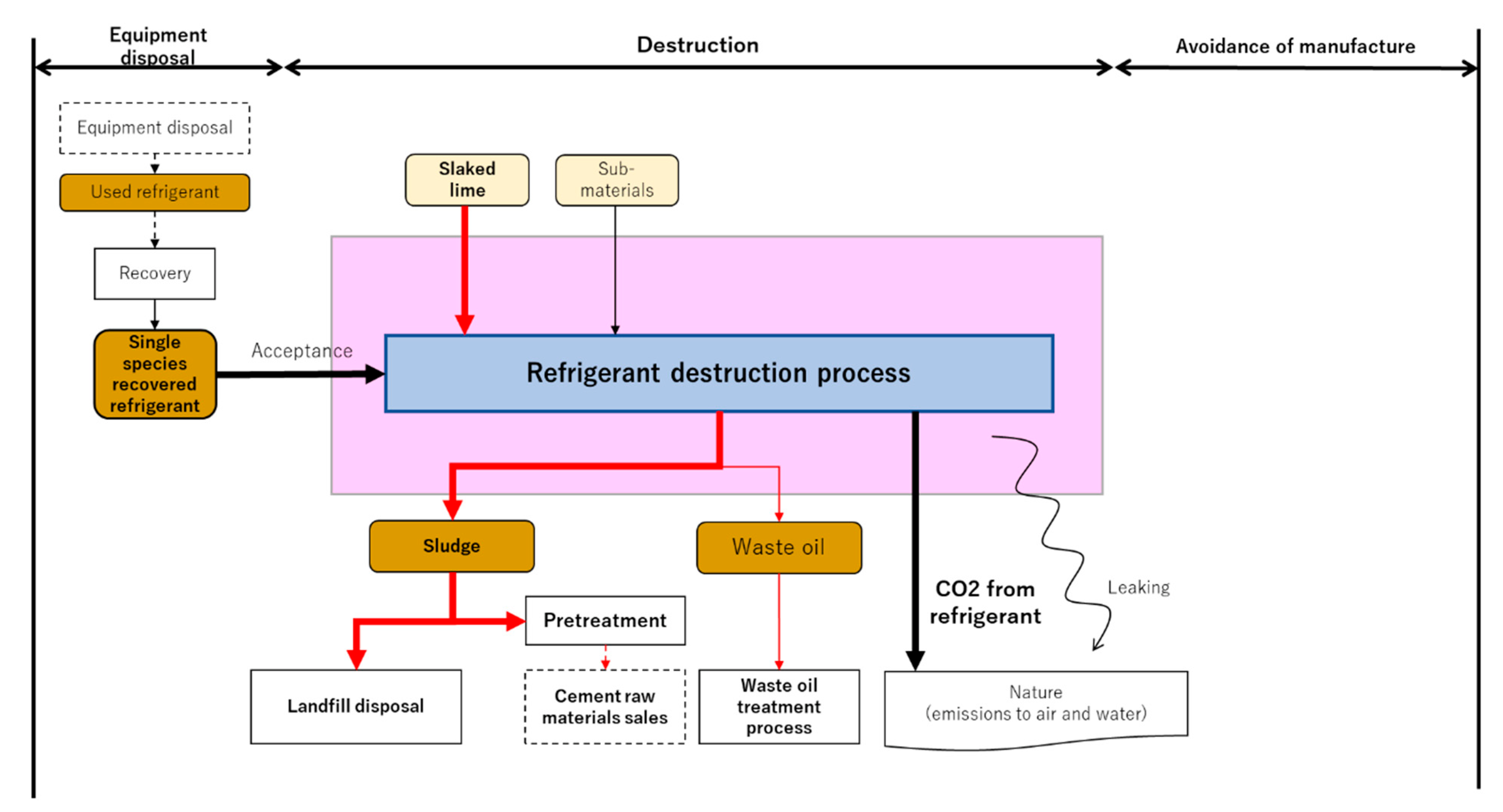
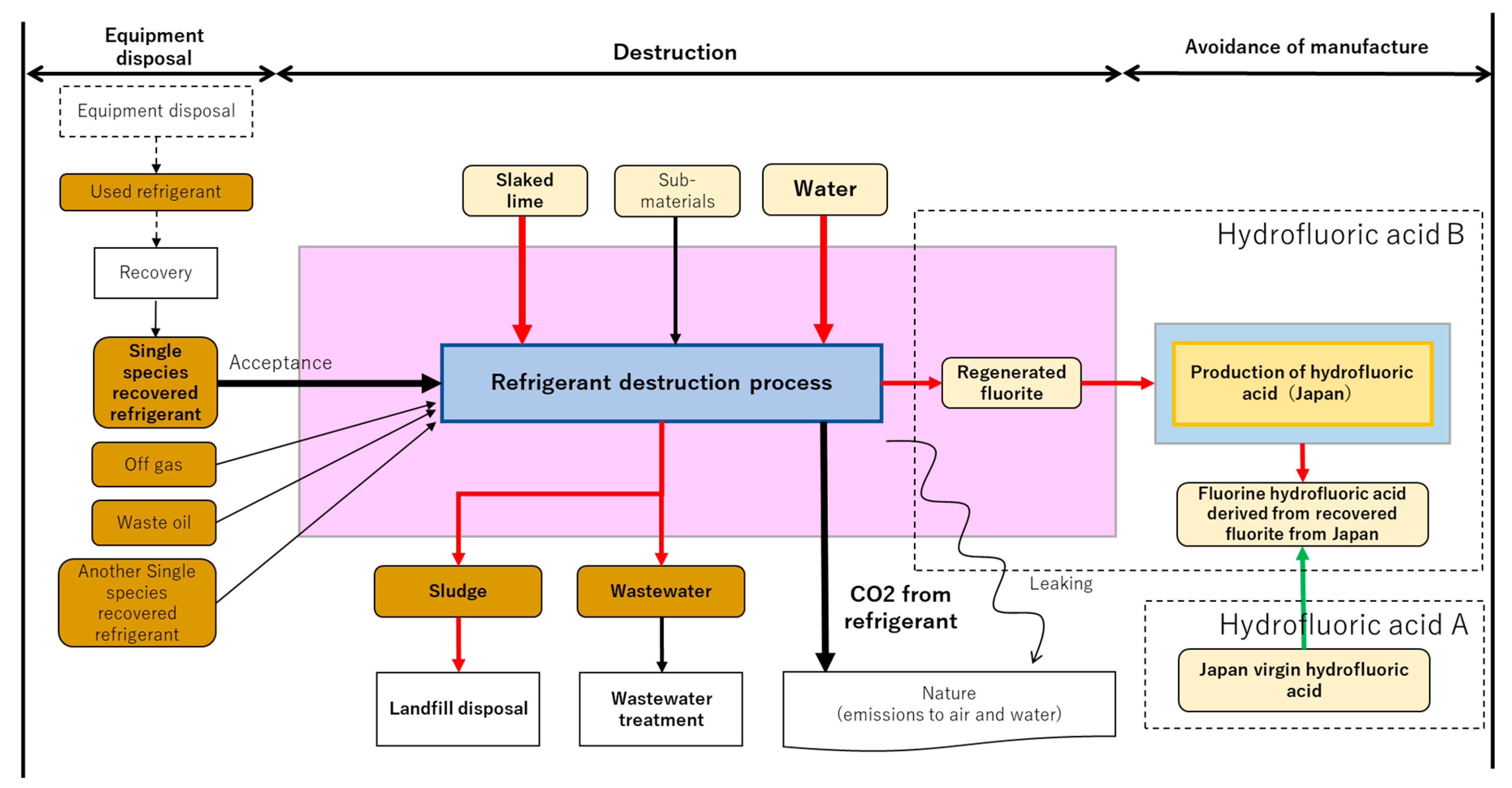
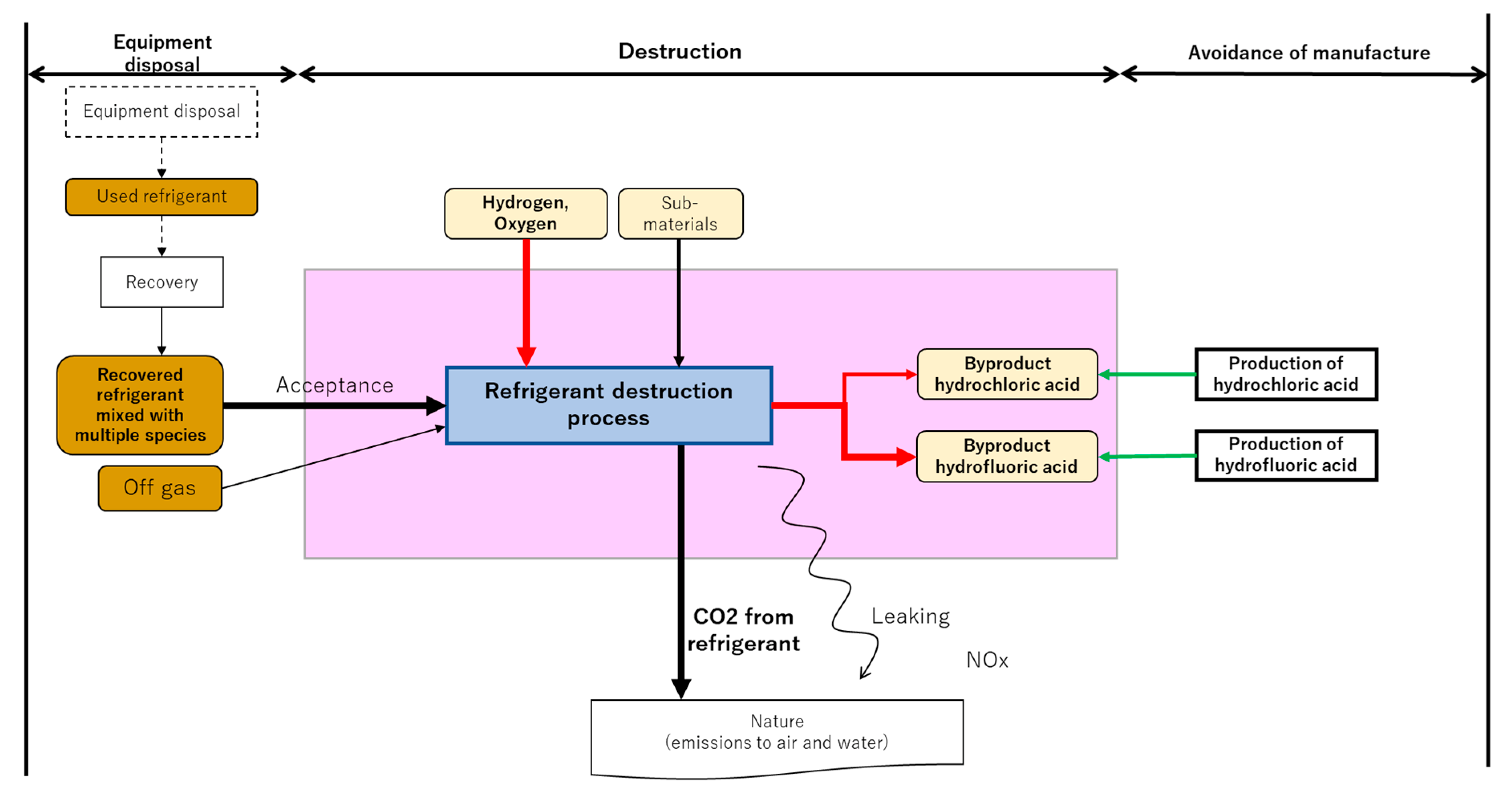


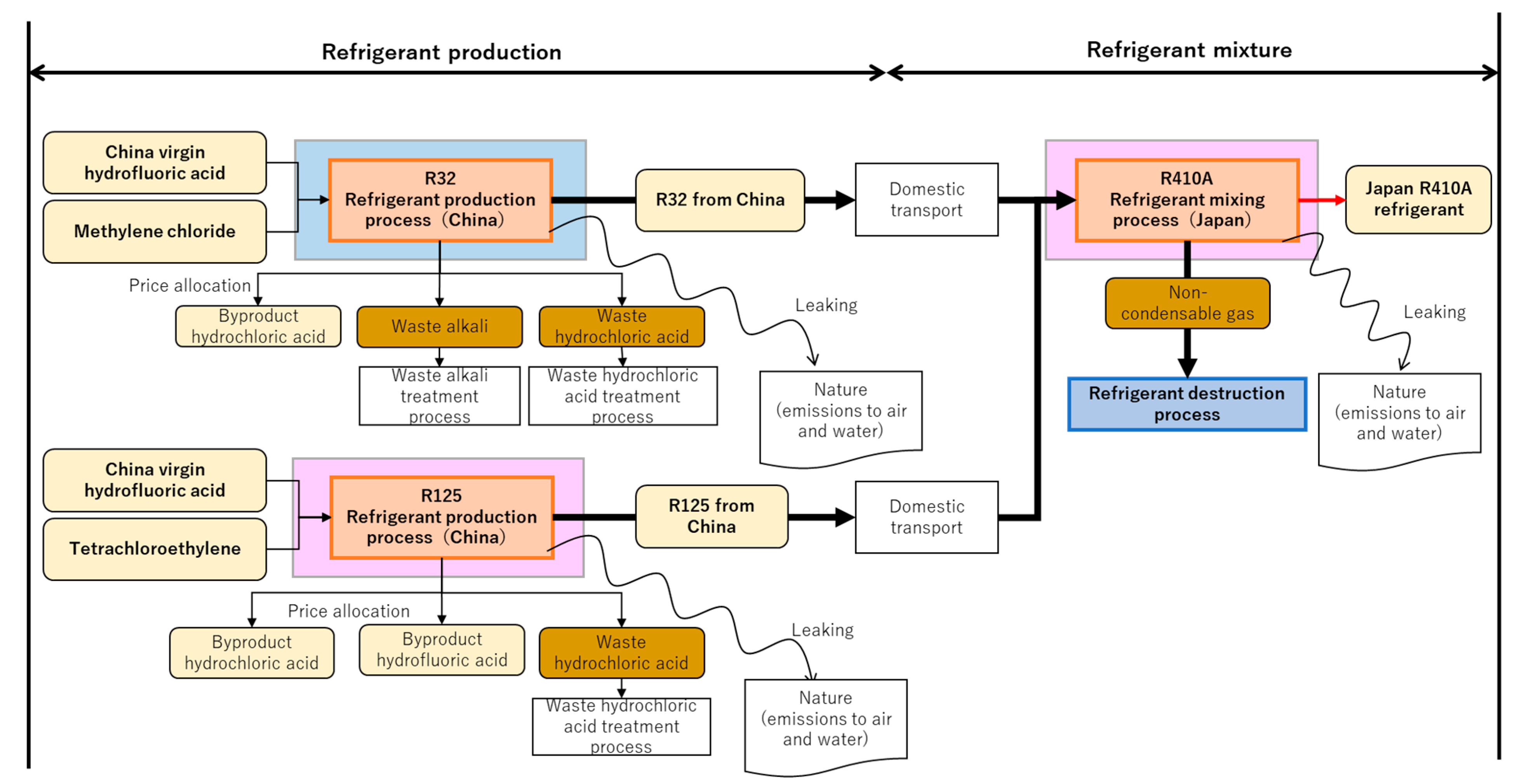
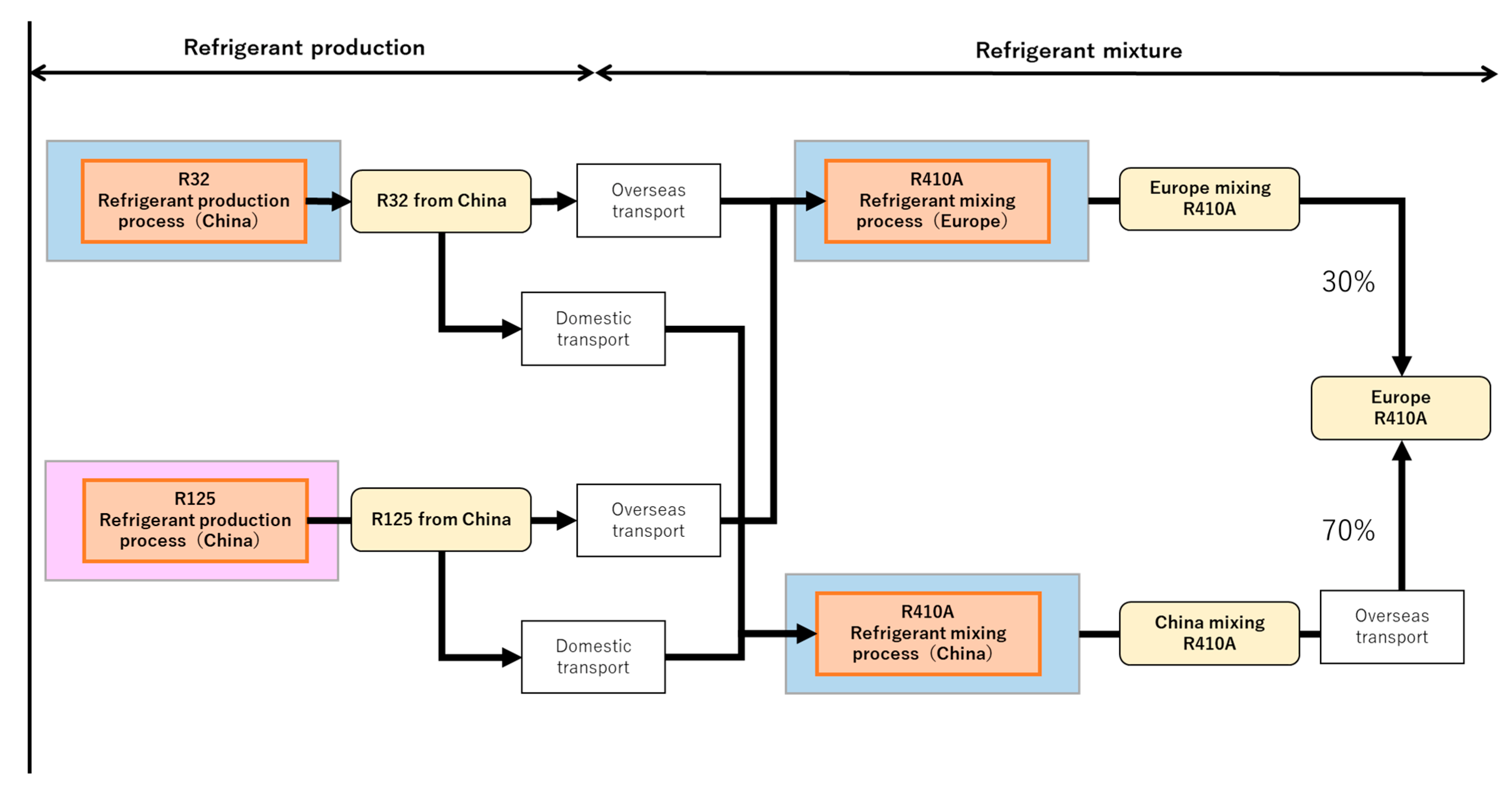
| Reclamation Technology | Location | Refrigerant | Recovery Ratio |
|---|---|---|---|
| Batch distillation | Japan | R22 | 95.0% |
| Batch distillation | Japan | R32 | 97.4% |
| Batch distillation | Japan | R410A | 97.4% |
| Batch rectification | Europe | R134a | 95.6% |
| Batch rectification | Europe | R410A | 95.6% |
| Simple distillation | Japan | R22 | 97.9% |
| Simple distillation | Japan | R32 | 98.3% |
| Simple distillation | Japan | R410A | 98.3% |
| Country of Implementation | Refrigerant | Country of Production | Total | Main Material | Secondary Materials | Energy | Other | Direct CO2 | Direct Refrigerant | Waste Treatment |
|---|---|---|---|---|---|---|---|---|---|---|
| Japan | R32 | Japan | 7.77 | 4.93 | 0.04 | 1.36 | 0.16 | x | 1.27 | 0.00 |
| China | 10.01 | 5.34 | 0.05 | 2.85 | 0.24 | x | 1.53 | 0.01 | ||
| R22 | Japan | 4.26 | 2.94 | 0.01 | 0.59 | 0.29 | x | 0.01 | 0.42 | |
| R410A | Japan | 10.07 | 4.89 | x | 3.22 | 0.45 | 0.02 | 0.91 | 0.57 | |
| Europe | R125 | China | 9.59 | 3.65 | 0.03 | 4.20 | 0.53 | 0.03 | 0.01 | 1.12 |
| R134a | Europe | 10.48 | 3.90 | 0.07 | 2.46 | 2.91 | x | 1.02 | 0.11 | |
| R410A | Europe | 10.35 | 4.89 | 0.00 | 3.22 | 0.73 | 0.02 | 0.91 | 0.57 |
| Refrigerant Treatment Method | Country of Implementation and Refrigerant | Refrigerant | Treatment Detail | Total | Slaked Lime | Energy | Other | Direct CO2 | Direct Refrigerant | Regenerated Fluorite | Recycled Acids | Reclaimed Refrigerant | Waste Treatment |
|---|---|---|---|---|---|---|---|---|---|---|---|---|---|
| Destruction | Japan | R410A | Superheated steam incineration | 27.62 | 8.65 | 14.22 | 2.85 | x | x | x | x | x | 1.89 |
| Liquid injection incineration | 98.55 | 7.62 | 93.55 | 2.77 | x | x | −9.16 | x | x | 3.77 | |||
| R32 | Superheated steam incineration | 27.79 | 7.56 | 16.01 | 2.48 | x | x | x | x | x | 1.75 | ||
| Liquid injection incineration | 123.55 | 7.31 | 116.53 | 3.37 | x | x | −8.79 | x | x | 5.12 | |||
| R22 | Liquid injection incineration | 75.73 | 6.60 | 68.98 | 1.33 | x | x | −4.25 | x | x | 3.08 | ||
| Europe | R410A | Gaseous/fume oxidation | 4.00 | x | 9.26 | 6.53 | x | x | x | −11.80 | x | 0.00 | |
| R134a | Gaseous/fume oxidation | 3.01 | x | 6.59 | 7.97 | x | x | x | −11.55 | x | 0.00 | ||
| Reclamation | Japan | R410A | Batch distillation | −118.51 | x | 2.09 | 0.57 | x | x | x | x | −129.22 | 8.05 |
| Simple distillation | −127.00 | x | 1.13 | 0.46 | x | x | x | x | −130.35 | 1.76 | |||
| R32 | Batch distillation | −100.18 | x | 2.92 | 0.59 | x | x | x | x | −115.47 | 11.78 | ||
| Simple distillation | −112.69 | x | 1.58 | 0.45 | x | x | x | x | −116.48 | 1.76 | |||
| R22 | Simple distillation | −54.85 | x | 1.38 | 0.46 | x | x | x | x | −60.21 | 3.53 | ||
| Europe | R410A | Batch rectification | −87.14 | x | 22.78 | 21.35 | x | x | x | x | −130.42 | −0.85 | |
| R134a | Batch rectification | −124.75 | x | 15.31 | 1.59 | x | x | x | x | −141.56 | −0.09 |
| Refrigerant Treatment Method | Country of Implementation and Refrigerant | Refrigerant | Treatment Detail | Total | Slaked Lime | Energy | Other | Direct CO2 | Direct Refrigerant | Regenerated Fluorite | Recycled Acids | Reclaimed Refrigerant | Waste Treatment |
|---|---|---|---|---|---|---|---|---|---|---|---|---|---|
| Destruction | Japan | R410A | Superheated steam incineration | 3.90 | 1.78 | 0.79 | 0.21 | 0.79 | 0.19 | x | x | x | 0.15 |
| Liquid injection incineration | 6.68 | 1.57 | 4.22 | 0.20 | 0.79 | 0.19 | −0.55 | x | x | 0.27 | |||
| R32 | Superheated steam incineration | 3.69 | 1.56 | 0.89 | 0.18 | 0.85 | 0.07 | x | x | x | 0.16 | ||
| Liquid injection incineration | 7.76 | 1.51 | 5.26 | 0.25 | 0.85 | 0.07 | −0.53 | x | x | 0.36 | |||
| R22 | Liquid injection incineration | 5.25 | 1.36 | 3.12 | 0.10 | 0.51 | 0.20 | −0.24 | x | x | 0.22 | ||
| Europe | R410A | Gaseous/fume oxidation | 0.96 | x | 0.51 | 0.32 | 0.79 | x | x | −0.67 | x | 0.00 | |
| R134a | Gaseous/fume oxidation | 0.95 | x | 0.36 | 0.38 | 0.86 | x | x | −0.65 | x | 0.00 | ||
| Reclamation | Japan | R410A | Batch distillation | −7.74 | x | 0.15 | 0.04 | x | 1.33 | x | x | −9.81 | 0.56 |
| Simple distillation | −8.12 | x | 0.06 | 0.03 | x | 1.53 | x | x | −9.90 | 0.15 | |||
| R32 | Batch distillation | −6.03 | x | 0.20 | 0.04 | x | 0.48 | x | x | −7.57 | 0.81 | ||
| Simple distillation | −6.83 | x | 0.09 | 0.03 | x | 0.54 | x | x | −7.64 | 0.15 | |||
| R22 | Simple distillation | −1.97 | x | 0.08 | 0.03 | x | 1.82 | x | x | −4.17 | 0.27 | ||
| Europe | R410A | Batch rectification | −6.83 | x | 1.34 | 1.61 | x | 0.00 | x | x | −9.89 | 0.11 | |
| R134a | Batch rectification | −8.94 | x | 0.91 | 0.11 | x | 0.00 | x | x | −10.01 | 0.05 |
| Refrigerant Treatment Method | Country of Implementation and Refrigerant | Refrigerant | Treatment Detail | Total | Slaked Lime | Electricity | Steam | Energy | Other | Direct CO2 | Direct Refrigerant | Regenerated Fluorite | Recycled Acids | Reclaimed Refrigerant | Waste Treatment |
|---|---|---|---|---|---|---|---|---|---|---|---|---|---|---|---|
| Destruction | Japan | R410A | Superheated steam incineration | 0.46 | 0.04 | 0.02 | x | 0.00 | 0.01 | 0.01 | 0.00 | x | x | x | 0.37 |
| Liquid injection incineration | 0.67 | 0.04 | 0.04 | 0.01 | 0.05 | 0.03 | 0.01 | 0.00 | −0.02 | x | x | 0.52 | |||
| R32 | Superheated steam incineration | 0.37 | 0.04 | 0.02 | x | 0.00 | 0.01 | 0.01 | 0.00 | x | x | x | 0.29 | ||
| Liquid injection incineration | 0.60 | 0.03 | 0.05 | 0.01 | 0.06 | 0.04 | 0.01 | 0.00 | −0.02 | x | x | 0.41 | |||
| R22 | Liquid injection incineration | 0.37 | 0.03 | 0.03 | 0.01 | 0.03 | 0.02 | 0.01 | 0.00 | −0.01 | x | x | 0.25 | ||
| Europe | R410A | Gaseous/fume oxidation | 0.04 | x | 0.01 | 0.01 | x | 0.02 | 0.01 | x | x | −0.03 | x | 0.01 | |
| R134a | Gaseous/fume oxidation | 0.04 | x | 0.01 | 0.01 | x | 0.03 | 0.01 | x | x | −0.03 | x | 0 | ||
| Reclamation | Japan | R410A | Batch distillation | −0.29 | x | 0.00 | x | 0.00 | 0.00 | x | 0.02 | x | x | −0.33 | 0.02 |
| Simple distillation | −0.30 | x | 0.00 | x | x | 0.00 | x | 0.03 | x | x | −0.33 | 0.00 | |||
| R32 | Batch distillation | −0.20 | x | 0.00 | x | 0.00 | 0.00 | x | 0.01 | x | x | −0.24 | 0.02 | ||
| Simple distillation | −0.22 | x | 0.00 | x | x | 0.00 | x | 0.01 | x | x | −0.24 | 0.00 | |||
| R22 | Simple distillation | −0.10 | x | 0.00 | x | x | 0.00 | x | 0.03 | x | x | −0.14 | 0.01 | ||
| Europe | R410A | Batch rectification | −0.36 | x | 0.06 | 0.01 | x | 0.08 | x | 0.00 | x | x | −0.51 | 0.00 | |
| R134a | Batch rectification | −0.54 | x | 0.04 | 0.01 | x | 0.01 | x | 0.00 | x | x | −0.59 | 0.00 |
| Destruction | Reclamation (Batch Distillation) | |||
|---|---|---|---|---|
| Total | Production | Destruction | ||
| GHG emissions (kgCO2eq) | 11.54 | 7.77 | 3.77 | 1.58 |
| Energy consumption (MJ) | 146.9 | 118.5 | 28.4 | 15.7 |
| LIME3 (USD) | 0.62 | 0.24 | 0.38 | 0.04 |
References
- International Energy Agency. The Future of Cooling; IEA Publications: Paris, France, 2018. [Google Scholar]
- Wan, H.; Cao, T.; Hwang, Y.; Radermacher, R.; Andersen, S.O.; Chin, S. A Comprehensive Review of Life Cycle Climate Performance (LCCP) for Air Conditioning Systems. Int. J. Refrig. 2021, 130, 187–198. [Google Scholar] [CrossRef]
- Troch, S.V. Harmonization of Life Cycle Climate Performance and Its Improvements for Heat Pump Applications; The University of Maryland: College Park, MD, USA, 2016. [Google Scholar] [CrossRef]
- Hill, W.; Papasavva, S. Life Cycle Analysis Framework; A Comparison of HFC-134a, HFC-134a Enhanced, HFC-152a, R744, R744 Enhanced, and R290 Automotive Refrigerant Systems. In Proceedings of the SAE 2005 World Congress & Exhibition, Detroit, MI, USA, 11–14 April 2005. [Google Scholar]
- Banks, R.E.; Sharratt, P.N. Environmental Impacts of the Manufacture of HFC-134a; Department of Chemical Engineering, UMIST: Manchester, UK, 1996; Unpublished Paper. [Google Scholar]
- Chen, W. A Comparative Study on the Performance and Environmental Characteristics of R410A and R22 Residential Air Conditioners. Appl. Therm. Eng. 2008, 28, 1–7. [Google Scholar] [CrossRef]
- Spatz, M.W.; Yana Motta, S.F. An Evaluation of Options for Replacing HCFC-22 in Medium Temperature Refrigeration Systems. Int. J. Refrig. 2004, 27, 475–483. [Google Scholar] [CrossRef]
- Aprea, C.; Greco, A.; Maiorino, A.; Masselli, C.; Metallo, A. HFO1234yf as a Drop-in Replacement for R134a in Domestic Refrigerators: A Life Cycle Climate Performance Analysis. Int. J. Heat Technol. 2016, 34, S212–S218. [Google Scholar] [CrossRef] [Green Version]
- Bovea, M.D.; Cabello, R.; Querol, D. Comparative Life Cycle Assessment of Commonly Used Refrigerants in Commercial Refrigeration Systems. Int. J. Life Cycle Assess 2007, 12, 299–307. [Google Scholar] [CrossRef]
- Cao, T.; Hwang, Y. HPT Annex 54: Heat Pump Systems with Low-GWP Refrigerants, 2021. The Technology Collaboration Programme Website. Available online: https://heatpumpingtechnologies.org/annex54/wp-content/uploads/sites/63/2022/02/iea-annext-54-2021-annual-report-v2-021822.pdf (accessed on 8 November 2022).
- Jovell, D.; Pou, J.O.; Llovell, F.; Gonzalez-Olmos, R. Life Cycle Assessment of the Separation and Recycling of Fluorinated Gases Using Ionic Liquids in a Circular Economy Framework. ACS Sustain. Chem. Eng. 2021, 10, 71–80. [Google Scholar] [CrossRef] [PubMed]
- Wang, H.; Wang, Y.; Mi, H.; Zang, J.; Wang, S. Analysis of Carbon Emission Energy Inventory from Refrigerant Production and Recycling Carbon Compensation. Appl. Sci. 2021, 12, 1. [Google Scholar] [CrossRef]
- The Intergovernmental Panel on Climate Change (IPCC). Climate Change 2022, Mitigation of Climate Change, Summary for Policymakers. 2022. Available online: https://www.ipcc.ch/report/ar6/wg3/downloads/report/IPCC_AR6_WGIII_SPM.pdf (accessed on 8 November 2022).
- European Environment Agency. Fluorinated Greenhouse Gases 2020. Available online: https://www.eea.europa.eu/publications/fluorinated-greenhouse-gases-2020 (accessed on 8 November 2022).
- Ministry of Economy, Trade and Industry (METI), Government of Japan. 2021 Allocation Operation Results Based on the Ozone Layer Protection Law. Available online: https://www.meti.go.jp/shingikai/sankoshin/seizo_sangyo/kagaku_busshitsu/flon_taisaku/pdf/017_04_00.pdf (accessed on 8 November 2022). (In Japanese)
- Fang, X.; Velders, G.J.M.; Ravishankara, A.R.; Molina, M.J.; Hu, J.; Prinn, R.G. Hydrofluorocarbon (HFC) Emissions in China: An Inventory for 2005–2013 and Projections to 2050. Environ. Sci. Technol. 2016, 50, 2027–2034. [Google Scholar] [CrossRef] [PubMed]
- Columbia University. Guide to Chinese Climate Policy. Available online: https://chineseclimatepolicy.energypolicy.columbia.edu/en/hfcs-and-cfcs#/_ftn1 (accessed on 8 November 2022).
- International Energy Agency. The Future of Heat Pumps. Available online: https://iea.blob.core.windows.net/assets/2cf6c5c5-54d5-4a17-bfbe-8924123eebcd/TheFutureofHeatPumps.pdf (accessed on 8 November 2022).
- United Nations. Amendment to the Montreal Protocol on Substances that Deplete the Ozone Layer. Available online: https://treaties.un.org/doc/Treaties/2016/10/20161015%2003-23%20PM/Ch_XXVII-2.f-English%20and%20French.pdf (accessed on 8 November 2022).
- United Nations Environment Programme, Current Use of HCFCs and HFCs. Available online: https://wedocs.unep.org/bitstream/handle/20.500.11822/26867/7877FS02_C_Uses_EN.pdf?sequence=1&isAllowed=y (accessed on 8 November 2022).
- U.S. Environmental Protection Agency. Phasedown of Hydrofluorocarbons: Allowance Allocation Methodology for 2024 and Later Years. Available online: https://www.epa.gov/system/files/documents/2022-10/FRL-8838-01-OAR_2024-HFC-Allocation_NPRM_20221019_ADMIN_pre-pub.pdf (accessed on 8 November 2022).
- Ministry of Economy, Trade and Industry (METI), Government of Japan. Report on the Evaluation and Examination of the Status of Enforcement of the 2013 Revised Fluorocarbon Emission Control Law. Available online: https://www.meti.go.jp/shingikai/sankoshin/seizo_sangyo/kagaku_busshitsu/flon_godo/pdf/20220628_1.pdf (accessed on 8 November 2022). (In Japanese)
- The California Air Resources Board. California Code of Regulations, Title 17, Division 3, Chapter 1, Subchapter 10 Climate Change, Article 4. Available online: https://ww2.arb.ca.gov/sites/default/files/barcu/regact/2020/hfc2020/frorevised.pdf (accessed on 8 November 2022).
- The California Air Resources Board. Final Statement of Reasons for Rulemaking, Including Summary of Comments and Agency Response. Available online: https://ww2.arb.ca.gov/sites/default/files/barcu/regact/2020/hfc2020/fsorrevised.pdf (accessed on 8 November 2022).
- Baba, N.; Kasai, S.; Itsubo, N. LCA Comparison of Refrigerant Reclamation and Destruction Applying LIME Method. In Proceedings of the 5th Annual Meeting of Life-Cycle Assessment Society of Japan, Tokyo, Japan, 20–22 March 2010; p. 138. [Google Scholar]
- U.S. Environmental Protection Agency. ODS Destruction in the United States and Abroad. Available online: https://www.epa.gov/sites/default/files/2018-03/documents/ods-destruction-in-the-us-and-abroad_feb2018.pdf (accessed on 8 November 2022).
- U.S. Environmental Protection Agency. On-Site Incineration: Overview of Superfund Operating Experience. Available online: https://www.epa.gov/sites/default/files/2015-04/documents/on_site_incineration.pdf (accessed on 8 November 2022).
- Ministry of the Environment, Government of Japan. Guidelines on the Destruction of CFCs in Japan. Available online: https://www.env.go.jp/content/900451343.pdf (accessed on 8 November 2022).
- Stratus Consulting Inc. Analysis of Equipment and Practices in the Reclamation Industry. Available online: https://www.epa.gov/sites/default/files/2015-08/documents/analysis_of_equipment_and_practices_in_the_reclamation_industry.pdf (accessed on 8 November 2022).
- U.S. Environmental Protection Agency. AP-42, Vol. I, CH 4.7: Waste Solvent Reclamation. Available online: https://www.epa.gov/sites/default/files/2020-10/documents/c4s07.pdf (accessed on 8 November 2022).
- Inaba, A.; Itsubo, N. Preface. Int. J. Life Cycle Assess 2018, 23, 2271–2275. [Google Scholar] [CrossRef]
- Karkour, S.; Ihara, T.; Kuwayama, T.; Yamaguchi, K.; Itsubo, N. Life Cycle Assessment of Residential Air Conditioners Considering the Benefits of Their Use: A Case Study in Indonesia. Energies 2021, 14, 447. [Google Scholar] [CrossRef]
- United Nations Framework Convention on Climate Change. Global Comparative Analysis of HFC and Alternative Technologies for Refrigeration, Air Conditioning, Foam, Solvent, Aerosol Propellant, and Fire Protection Applications. Available online: https://unfccc.int/sites/default/files/wamatt054_1.pdf (accessed on 8 November 2022).
- Ministry of Economy, Trade and Industry (METI), Government of Japan. Aggregation Results of Recycled and Destroyed amounts of Fluorocarbons in FY2021 Based on the Fluorocarbons Emissions Control Law. Available online: https://www.env.go.jp/content/000074323.pdf (accessed on 8 November 2022). (In Japanese)

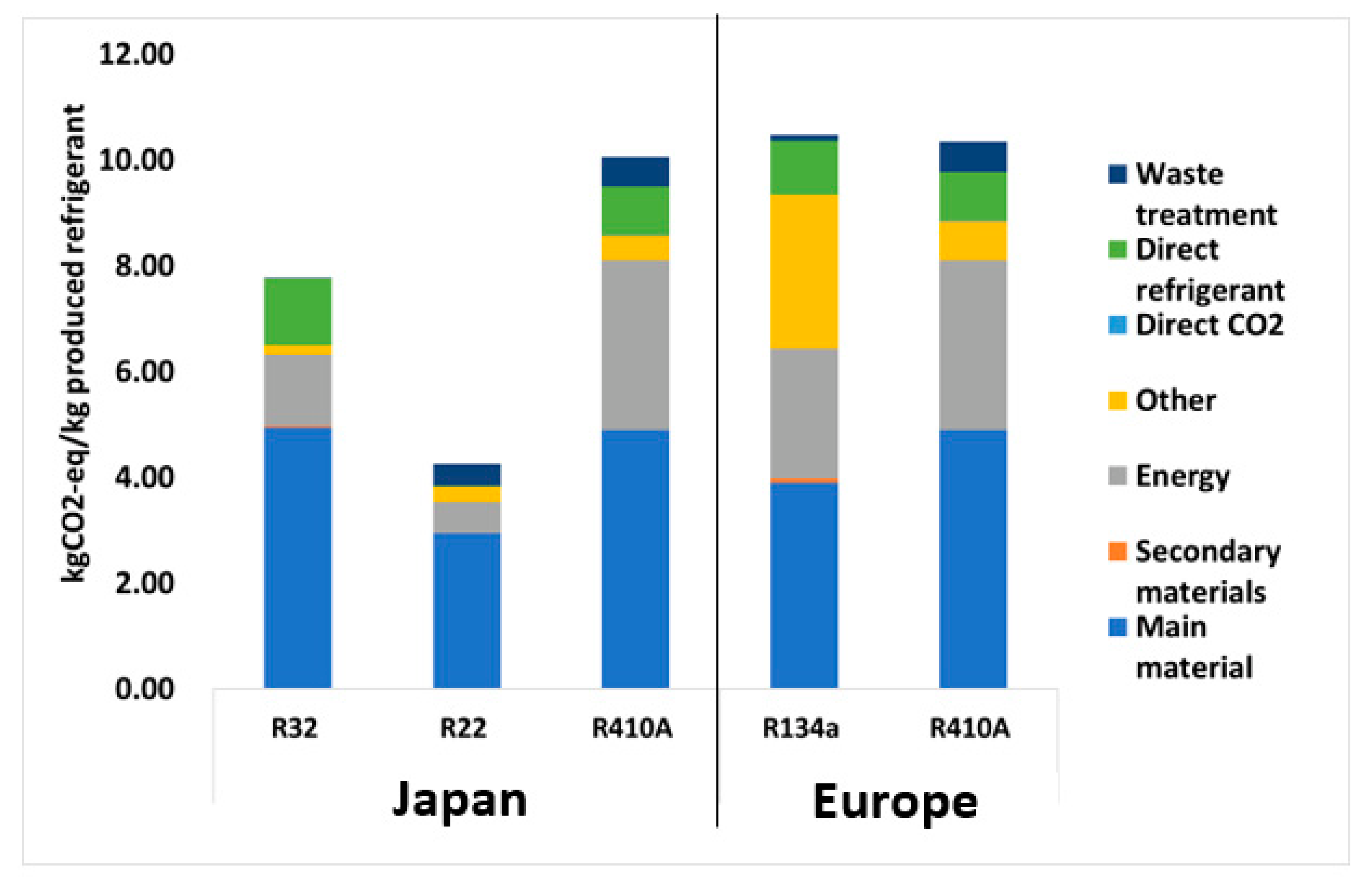
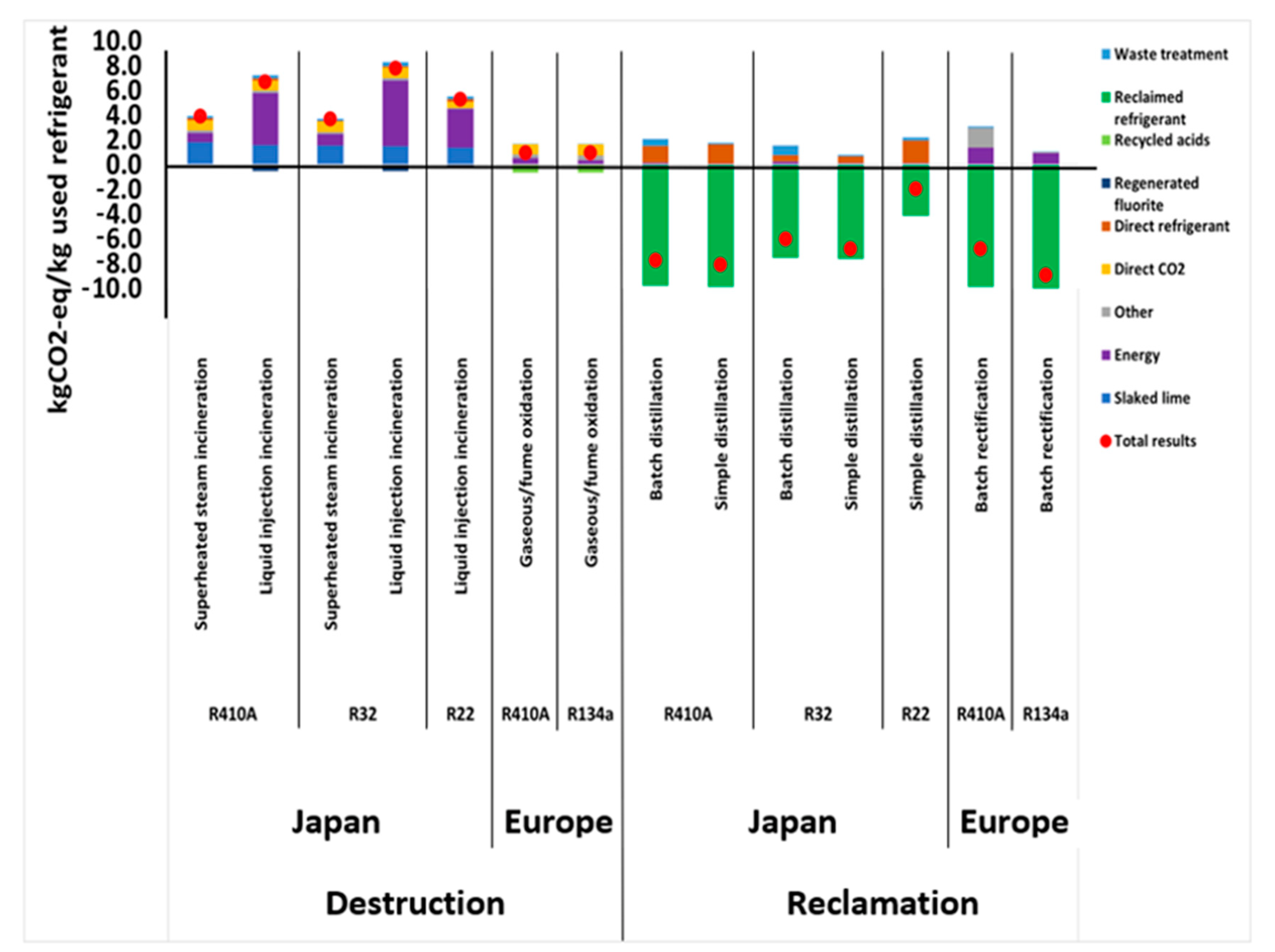
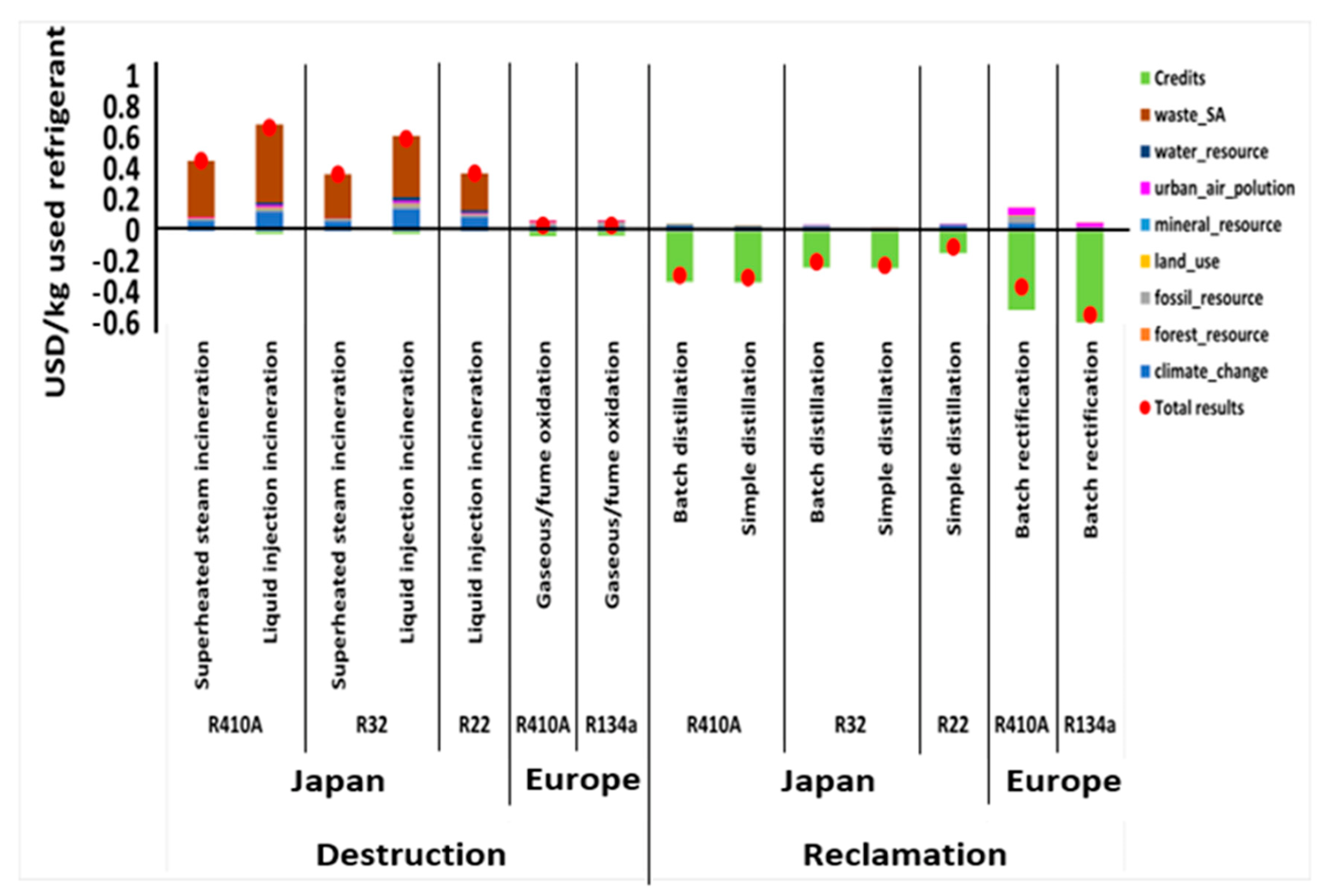
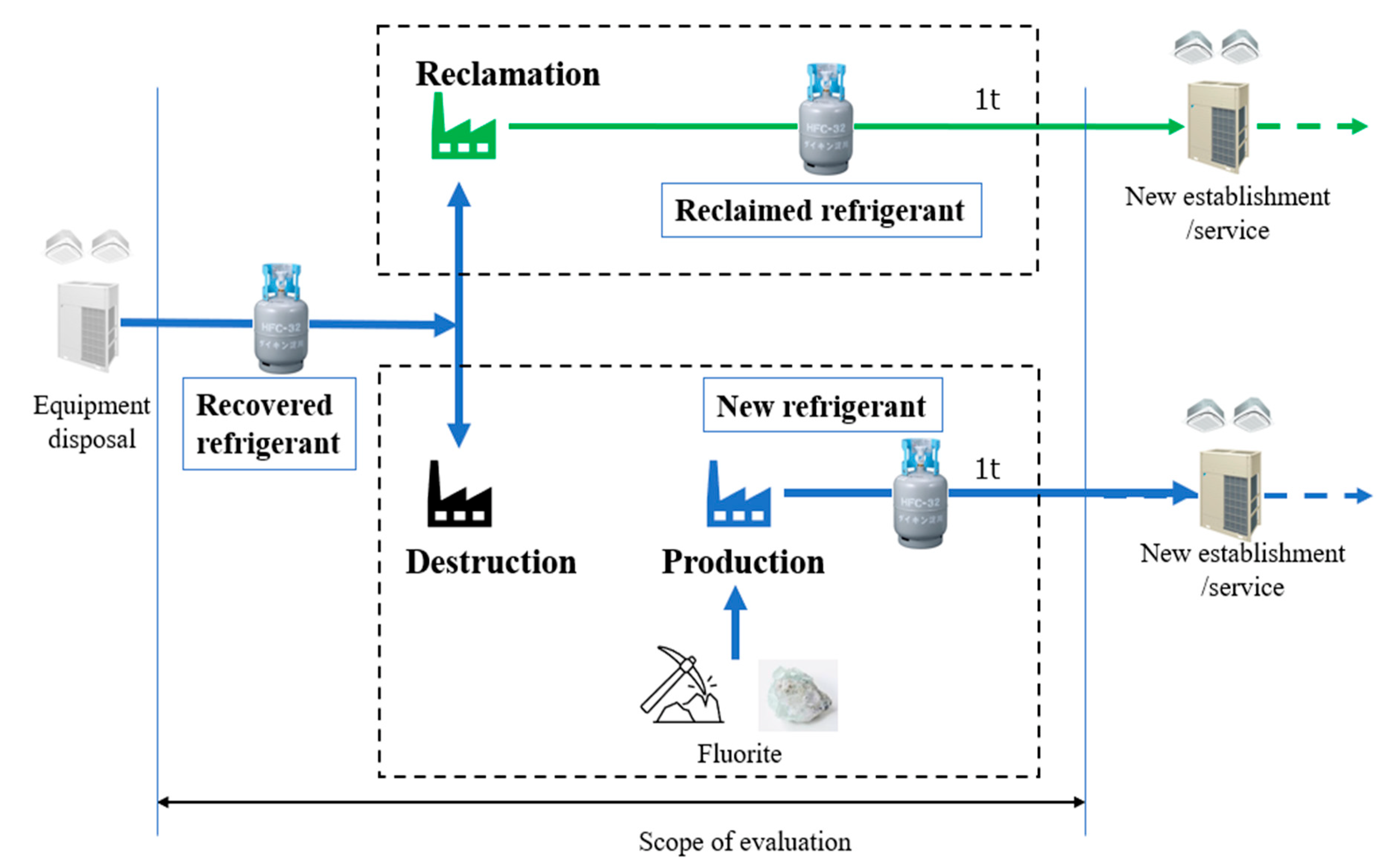

| Condition of Refrigerant at Recovery | Separate Collection of Gas Species | Collective Collection of Gas Species | |||||
|---|---|---|---|---|---|---|---|
| Processing Category | Region | Treatment Method\Refrigerant Name | R410A | R32 | R22 | R410A | R134a |
| Destruction | Japan | Superheated-steam incineration | ● (2) |  ▲ ▲ | ● (2) | ||
| Liquid-injection incineration | ● (2) |  ▲ ▲ | ● (2) | ||||
| Europe | Gaseous/fume oxidation | ● (1) | ● (1) | ||||
| Reclamation | Japan | Batch distillation | ● (2) | ● (1) ▲ | ● (2) | ||
| Simple distillation | ● (3) |  ▲ ▲ | ● (2) | ||||
| Europe | Batch rectification | ● (1) | ● (1) | ||||
| Process | Data Type | Data | |
|---|---|---|---|
| 1 | Manufacture | Primary data | Power, heat, and raw material inputs, refrigerant leaks, and by-products required for the refrigerant production process. |
| Secondary data | The data required for the evaluation of the upstream in the chain of primary data input/output flow. | ||
| 2 | Reclamation | Primary data | The amount of electricity, heat, secondary material inputs, refrigerant leakage, production of reclaimed refrigerant, waste generation, waste treatment, and destruction of refrigerant that could not be reclaimed in the used refrigerant reclamation process. |
| Secondary data | The data required for the evaluation of the upstream in the chain of primary data input/output flow. | ||
| 3 | Destruction | Primary data | The amount of electricity, heat, chemical inputs, refrigerant leakage, waste generation, and waste treatment methods required for the used refrigerant destruction process. |
| Secondary data | The data required for the evaluation of the upstream in the chain of primary data input/output flow. |
| Refrigerant Type | GWP AR5 |
|---|---|
| kgCO2/kg | |
| R32 | 677 |
| R125 | 3170 |
| R410A | 1924 |
| R22 | 1760 |
| R134a | 1300 |
Disclaimer/Publisher’s Note: The statements, opinions and data contained in all publications are solely those of the individual author(s) and contributor(s) and not of MDPI and/or the editor(s). MDPI and/or the editor(s) disclaim responsibility for any injury to people or property resulting from any ideas, methods, instructions or products referred to in the content. |
© 2022 by the authors. Licensee MDPI, Basel, Switzerland. This article is an open access article distributed under the terms and conditions of the Creative Commons Attribution (CC BY) license (https://creativecommons.org/licenses/by/4.0/).
Share and Cite
Yasaka, Y.; Karkour, S.; Shobatake, K.; Itsubo, N.; Yakushiji, F. Life-Cycle Assessment of Refrigerants for Air Conditioners Considering Reclamation and Destruction. Sustainability 2023, 15, 473. https://doi.org/10.3390/su15010473
Yasaka Y, Karkour S, Shobatake K, Itsubo N, Yakushiji F. Life-Cycle Assessment of Refrigerants for Air Conditioners Considering Reclamation and Destruction. Sustainability. 2023; 15(1):473. https://doi.org/10.3390/su15010473
Chicago/Turabian StyleYasaka, Yoshihito, Selim Karkour, Koichi Shobatake, Norihiro Itsubo, and Fumiaki Yakushiji. 2023. "Life-Cycle Assessment of Refrigerants for Air Conditioners Considering Reclamation and Destruction" Sustainability 15, no. 1: 473. https://doi.org/10.3390/su15010473
APA StyleYasaka, Y., Karkour, S., Shobatake, K., Itsubo, N., & Yakushiji, F. (2023). Life-Cycle Assessment of Refrigerants for Air Conditioners Considering Reclamation and Destruction. Sustainability, 15(1), 473. https://doi.org/10.3390/su15010473






